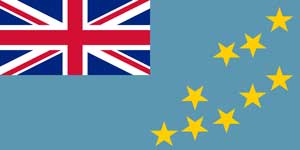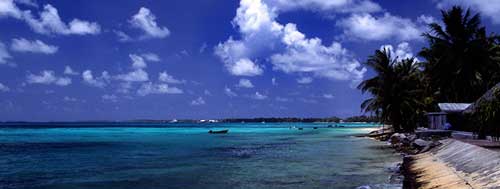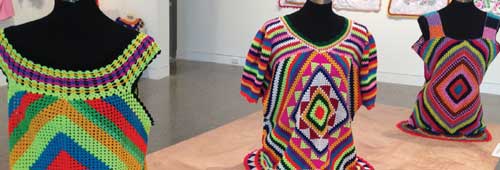Map
Flag

Quick facts
Official Name: Tuvalu
Indigenous Peoples: Tuvaluans
Official Languages: Tuvaluan, English
Political Status: Independent nation, in association with Great Britain
Capital: Funafuti
Population: 10,837 (2012 est.)
Greeting: Talofa atu
History and geography

Tuvalu consists of nine low lying atolls in the South Pacific located midway between Hawai’i and Australia. It is comprised of three reef islands and six atolls. Its nearest neighbors are Kiribati, Nauru, Samoa and Fiji. The total land area of the islands of Tuvalu is 26 sq km (10 sq mi).
The population of Tuvalu, formerly known as the Ellice or Lagoon Islands, is thought to have dropped from 20,000 in 1850 to 3,000 in 1875, due to slave traders and imported European diseases. The Gilbert and Ellice Islands Protectorate was established by Britain in 1892 (the Gilbert Islands are now called Kiribati) and the protectorate became a colony in 1916.
The first European explorer to make contact with Tuvalu was Álvaro de Mendaña y Neyra, a Spanish explorer. He sailed westward across the Pacific in 1567-8 to discover, explore and name a substantial part of the eastern half of the Solomon Islands. Such was the first and only European contact with Tuvalu for almost two centuries. The atolls were ignored until 1781 when the Spanish trader Don Francisco Maurelle was forced well south of the Equator by unfavorable winds on a routine journey from Manila to Mexico.
Captain Arent de Peyster, an American, is given credit for the rediscovery of Tuvalu. He was in command of the British brigantine Rebecca, when in May 1819, he discovered a group of 14 islets that appeared to be inhabited.
In the next decade, more traders and whalers briefly visited Tuvalu, especially after the discovery of the Central Pacific whaling grounds in 1818. Tuvalu’s waters were frequented by American whalers in the 1800s. Seamen occasionally deserted and settled ashore, while some islanders became crewmen. Some European beachcombers became traders and agents for firms in Australia, Germany and the US, and organized the export of coconut oil or copra.
During the 1860s slave traders, or “blackbirders,” carried off about 400 islanders, mainly from Funafuti and Nukulaelae, to work in Peru. None of them ever returned. Other Tuvaluans were later recruited for plantations in Fiji, Samoa, and Hawai’i. European diseases caused many deaths among the islanders.
A well-known Australian author, George Lewis “Louis” Becke, spent time as a trader in Tuvalu. Before he took to writing, he traveled extensively in the South Pacific, finding employment in may areas. In early 1880, he took up a position with trader Tom de Wolf in Nanumanga, and eventually opened his own store in Nukufetau in February 1881. There, he married native Nelea Tikena.
A referendum held in 1974 established that most Ellice islanders wanted a separate status from the Gilbert Islands. The country was renamed Tuvalu, an old name meaning “eight standing together” (Tuvalu has nine islands or island groups, but one has very little land above sea level). The Ellice Islands became a separate British dependency in October 1975, and gained independence as Tuvalu in October 1978.
In February 2000, the UN accepted Tuvalu as the organization’s 189th member, and in September 2000 it became a full member of the Commonwealth, having been a special member since it joined in 1978. In 2001, New Zealand agreed to accept an annual quota of Tuvaluans wishing to emigrate as the sea level rises, starting from 2002 and continuing for at least 30 years. In 2003, discussions were under way about emigration of Tuvaluans to Niue, where the population had declined due to emigration to New Zealand.
Most Tuvaluans are subsistence farmers. A small amount of income is brought in by the export of copra and the sale of stamps. Fees are also collected from foreign fishing fleets. Tuvalu depends heavily on foreign aid. It imports most of its food, fuel and manufactured goods.
Arts and culture

Tuvaluans are known for their decorative mats and fans, canoes, fish hooks, as well as women’s skirts and tops that are used during traditional performances.
The Museum of New Zealand holds a collection of Tuvaluan artifacts and handicrafts, including a man’s jacket and a Mother Hubbard dress made from pandanus leaves. Christian missionaries had demanded that the women of Tuvalu adopt more conservative clothing as compared to traditional Tuvaluan clothing.
Traditional headbands (fau o aliki) or headdresses (kula, pale) made out of pandanus, such as those prepared for the inauguration of a chief (aliki), follow a specific cultural design. The task of creating the headband or headdress is often reserved to a specific person, such as a daughter of the chief.
Traditional floral garlands of a young woman (Te fou ote tamafine) or a headdress for a woman (fou) also follow specific designs using tiale (gardenia), pua (Guettarda speciosa) and melia (Frangipani) plants.
Te titi tao, a traditional skirt placed upon another skirt – a titi kaulama – and tops (teuga saka), headbands, armbands, and wristbands continue are used in performances of the tradition dance music of Tuvalu, such as the faatele. The faatele is an action song style, well known in Tuvalu. Seated singers repeat verses of a song faster and faster until they reach a climax and stop abruptly, while standing dancers act out the lyrics. Faatele may be done competitively, be an adjunct to other festivities, or be an end in themselves, and may be composed and choreographed by anyone with the inspiration to do so.
The faatele, in its modern form, is performed at community events and to celebrate leaders and other prominent individuals, such as the Duke and Duchess of Cambridge, who visited Tuvalu in September 2012.
Tuvaluans also enjoy other kinds of musical activity, including singing hymns, Western-style dancing, and pop music. The verbal arts are confined to oratorical performances, which are performed by older men.
Tuvaluan men also participate in performances of traditional music in costumes that follow traditional style, made from pandanus leaves and synthetic or natural cloth that incorporate bold colors. Marriage ceremonies are usually conducted with men and women in traditional costumes.
The churches and community buildings used for wedding celebrations and community activities (the falekaupule or maneapa) are often decorated by the community with the exterior painted with white paint, known as lase. Lase is made by burning a large amount of dead coral with firewood. The resulting whitish powder is mixed with water and painted on the buildings.
Artists with Tuvaluan ancestry in migrant communities, such as the Tuvaluan community in Auckland, New Zealand, produce work using traditional techniques and media and also using modern materials and contemporary Polynesian graphic designs.
Selina Tusitala Marsh, of Sāmoan, Tuvaluan, English and French descent, is a published poet. She represented Tuvalu at the London Olympics Poetry Parnassus event in 2012.
